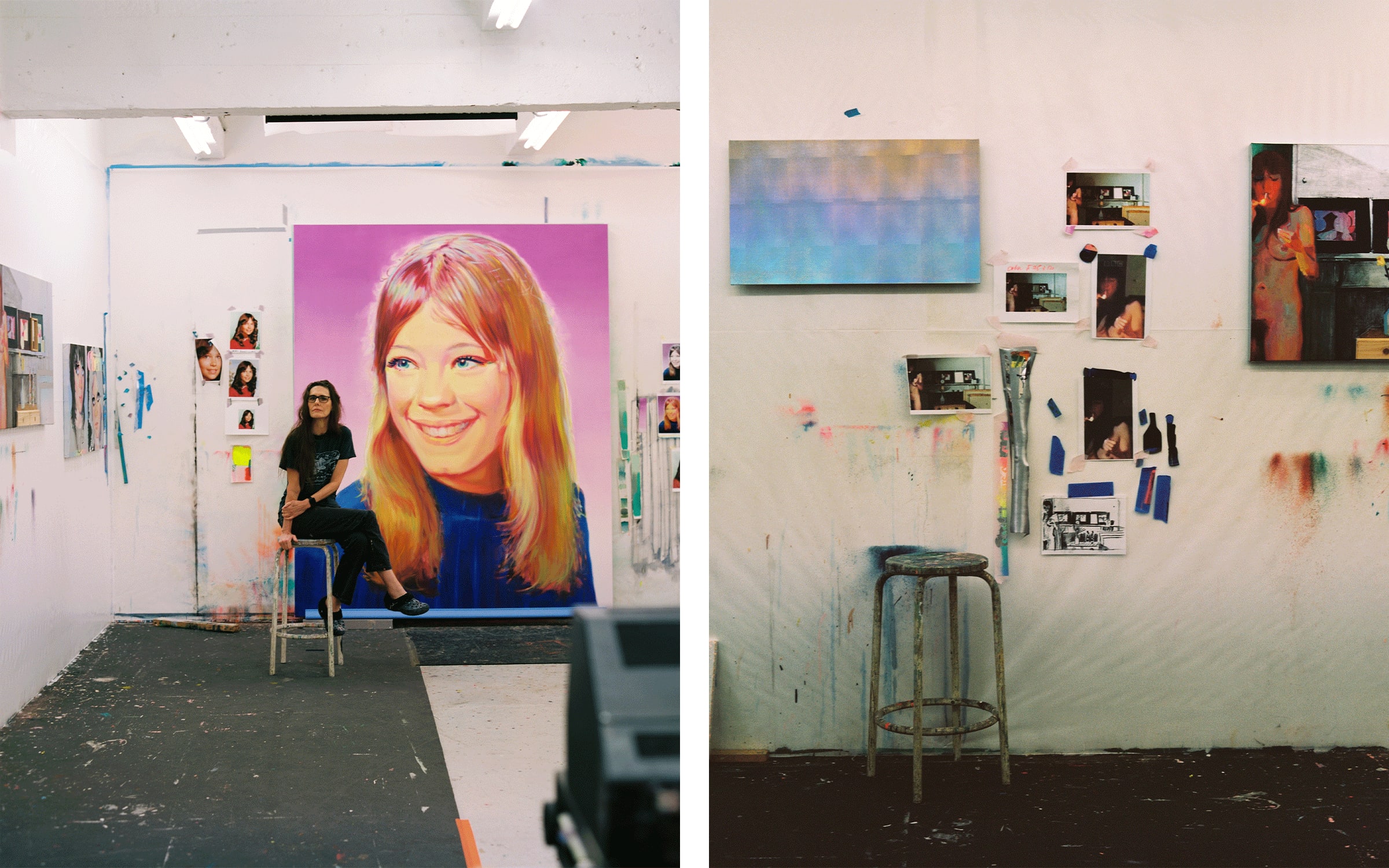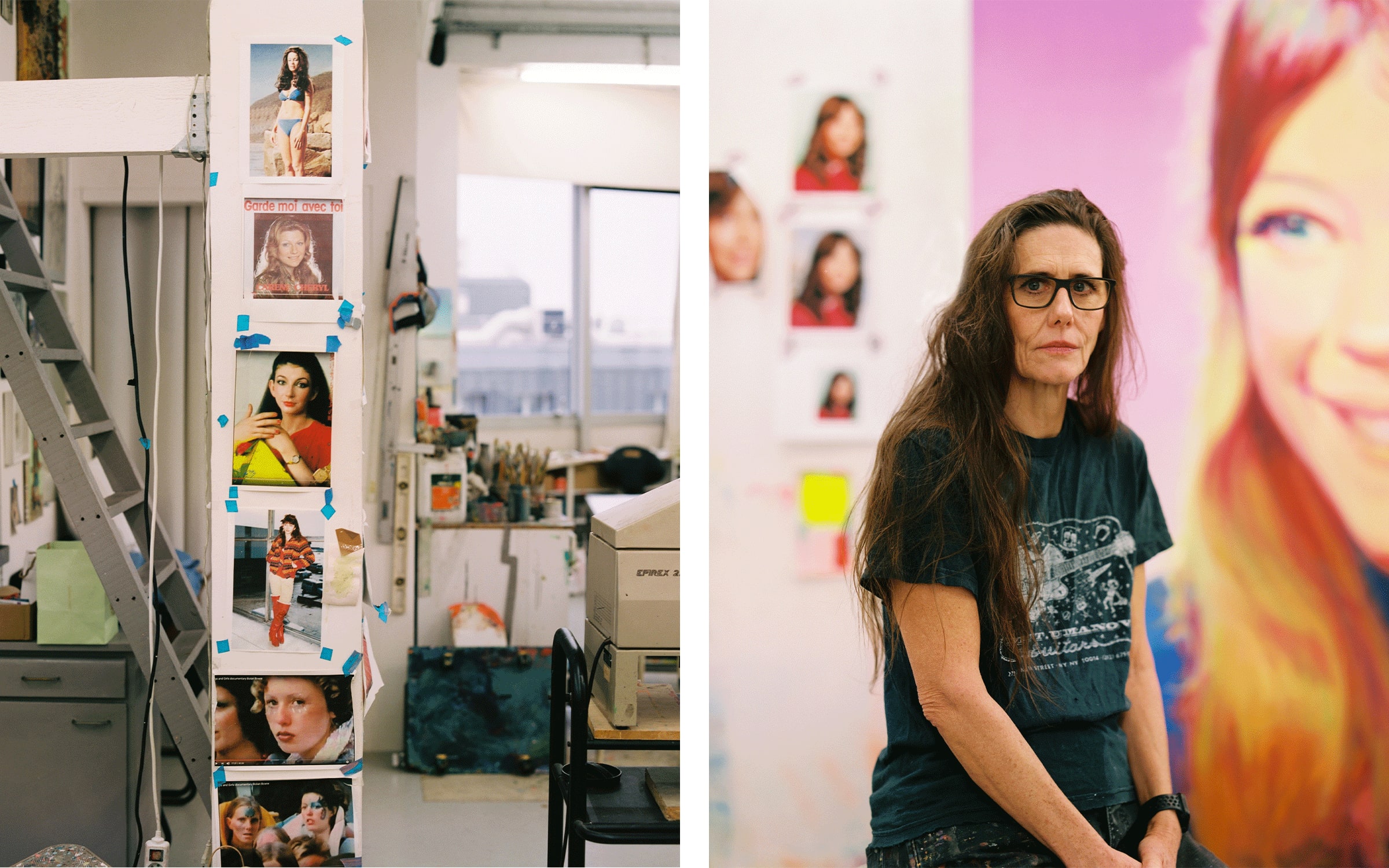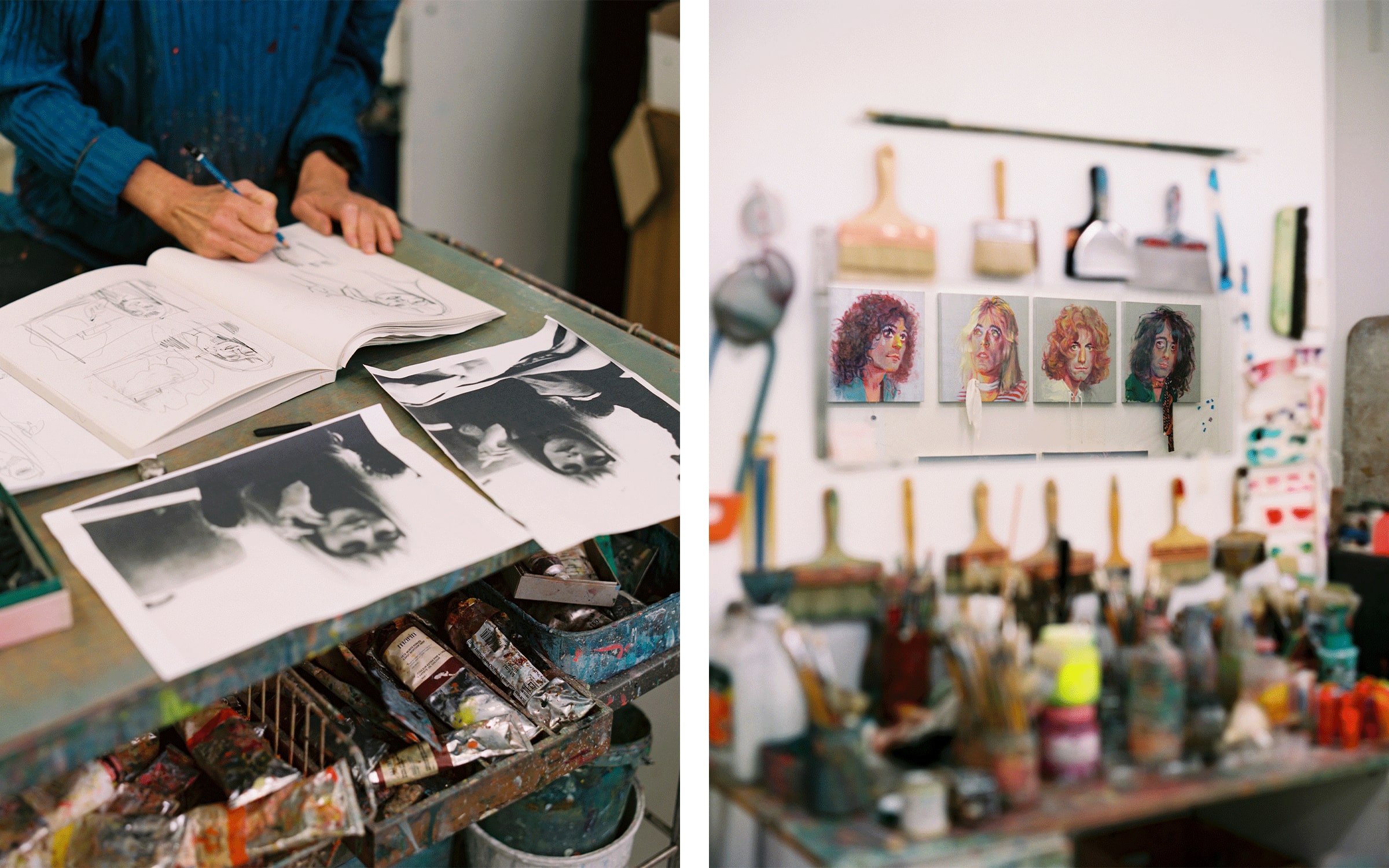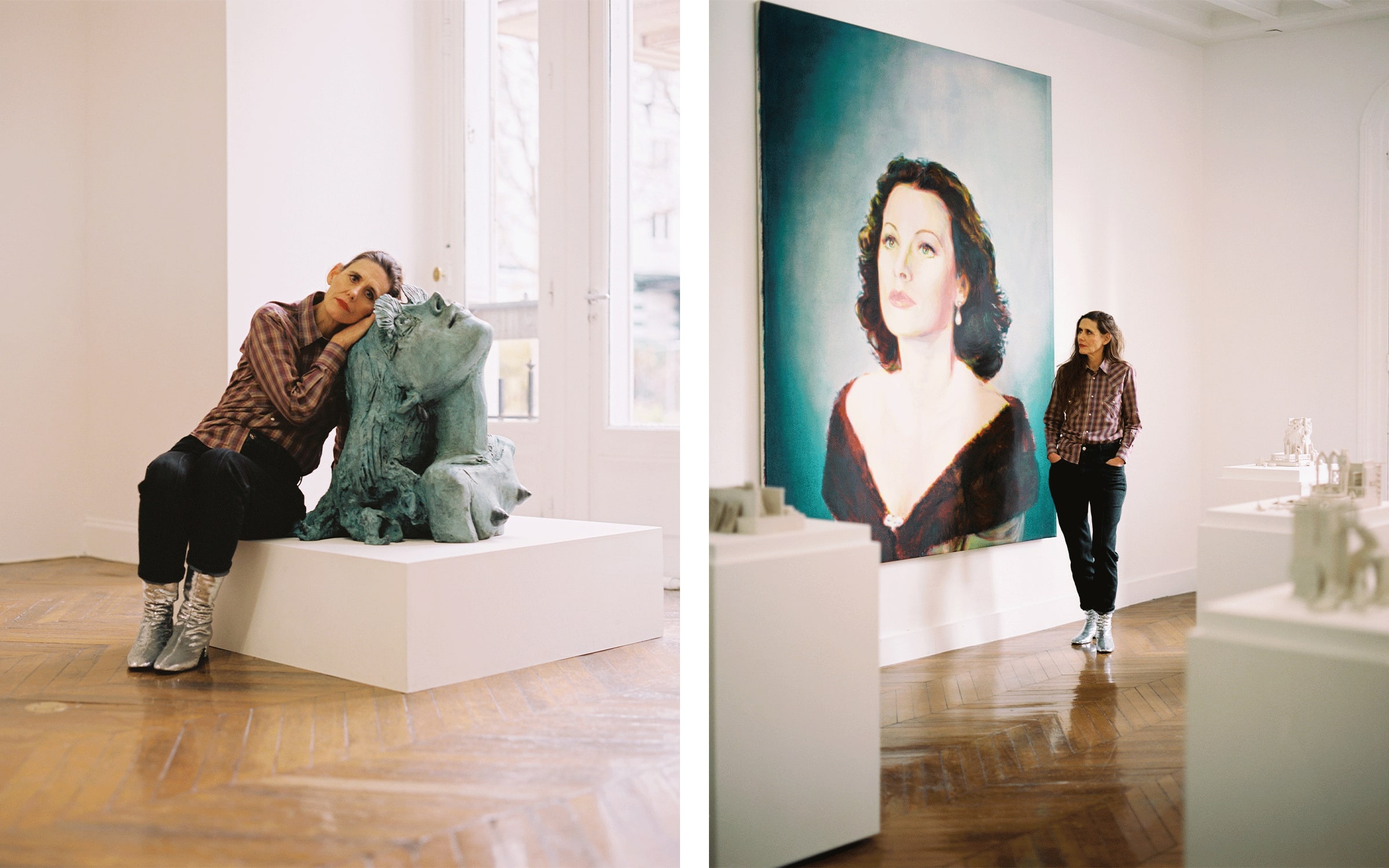
Nina Childress sits down with Thomas Chatterton Williams to discuss painting, punk, and the politics of bad taste.
The French-American artist Nina Childress has built a decades-spanning career around the indefatigable interrogation of ‘bad’ art and taste. Shaped by the rebellious spirit of punk rock, her approach has always been heterodox and fluid. Since the 1980s, the painter has relied on a wide variety of aesthetic strategies and styles, from blurred compositions evocative of Gerhard Richter’s photo paintings to garish oil-on-canvas recreations of 1960s nudist films. Yet despite her best efforts, these works intrigue and please the eye, colliding received notions of high and low, and scrambling oversimplified conceptions of good and bad.
Following the dual publication of her hefty catalogue raisonné, Nina Childress: 1081 Peintures, and a slim and playful autobiography last September, I met Childress at her tidy apartment in the 10th arrondissement. We happen to be neighbors. The artist teaches painting at the Beaux-Arts de Paris and keeps a studio in the suburbs. She’s friendly, softly-spoken, and modest in her dress – were I to pass her on the street I could easily imagine she were the principal of the local middle school. For Childress, 2023 is going to be a busy year: ‘Cils, poils, cheveux’ is on until April 23 at the Musée des Beaux-Arts de la Chaux-de-Fonds in Switzerland and UNISEXE will open at Art : Concept in Paris in mid-May. Back at her flat, we sipped green tea from her collection of mugs emblazoned with portraits of the British royal family, while workers noisily repaired a patch of roof outside her doorway.

Thomas Chatterton Williams: Tell me about your two beautiful books, a catalogue raisonné, 1081 Peintures, and your autobiography, co-written with Fabienne Radi.
Nina Childress: It’s the story of somebody who was young in the 1980s, who started out as a punk, and then wanted to paint. Although, it was not at all fashionable to be painting in the 1990s.
Figurative painting?
Everything had to be conceptual. I had to explain all this in the book in a lively way so that people who are not really interested in art could understand. I also ended up, almost by accident, talking about my lovers, my husband, my children. When the publisher read it, she said, ‘We could sell it separately. We don’t need all the paintings!’
You were born in Pasadena in 1961.
My parents had me quite young.

They’re American or French?
My father’s from Texas originally. He’s a doctor in physics and he did his graduate degree at – was it Princeton? I don’t know.
Smart guy.
Smart guy, yes. And he met my mother who was French and had gone to the US because she had problems with her family. Her aunt had married a GI during the war, so she had a landing point in Pasadena. My mother and father met and very quickly married. They had two children. I was the first, my brother came two years later. After that my dad had a job at NYU so they moved to New York City when I was three. And then my mother got really homesick, so she took us back to France.
Without him?
For a couple of years he came back and forth. But in the end, he met another woman and he remarried. I found out much later, because my mother tried to make everything seem normal, and I never returned to California until I was something like 55 years old.
Oh, wow – really?
I wanted to be there for my work, not for personal reasons. Then I finally got a residency, so I stayed in LA for a week and met with my cousin who took me to Pasadena. She took me everywhere and I recognized everything. I really experienced trauma when I was young; I experienced exile in a way. And I had to keep these memories of the US very strong in my head because they were the only thing I had left from there. It’s when I went back that I realized all I went through. In my work, you find a lot of California.
America is kind of an imaginary place for you.
Not imaginary since it’s also very present in the media, movies, and music. For example, I’ve been working on the topic of the Runaways, a musical group from LA. They were just two years older than I am, so I could have been around. I’m always very sensitive to that.
In 1990, I had a very significant accident. My real work started after that. At the time, I was almost 30 years old.
What happened?
I had a paragliding accident. When I recovered, I did this painting, which is a close-up of a banana. It’s also the shadow of a banana. So it’s very metaphysical. Actually, it’s lost – I just have a photograph now. But it is important because after this work, I took responsibility for my art. Before that, I was trying to make stupid, conceptual work. At the time, I was very poor, I couldn’t buy canvasses. I picked up materials on the street and I got kicked out of my gallery.
But you were extremely productive.
I was obsessed with painting. I had so little money I would do portraits of children to pay my bills. I put those in the book because I wanted to show that I had to do that work to live. Then I decided, what the heck, I’m just going to do what I want. I’ll do drawings, I’ll do little opera paintings, I will do sort of bad painting. Ironic. It’s when I stopped looking for something to hold onto as a style, or for something that would define my work, that things happened. I was 43, so it took me a long time. I try to teach my students to do it sooner than I did.
You spoke – and the book talks – about your abiding interest in punk culture and music. How would you describe the through-line that connects all the work throughout your career?
Contradictions.

Contradiction is what you’re attracted to?
Provocation and contradictions – and something I learned from punk which is both attraction and a tingle.
And repulsion?
Not repulsion really, but when you just [makes a poking gesture] a little bit.
When you poke?
Yeah, poking. Poking in the side like this. Because that’s my personality. But this [poking gesture] plus 40 years of painting makes it really interesting.
On a more basic level, what does the punk sensibility mean or imply aesthetically?
Being a punk was a way of being nonconformist. So that’s saying, ‘Fuck you.’ Aesthetically it’s to say: ‘Feel free to do what you want.’
Feel free to do what you want, but you still do make beautiful visual representations.
You think they’re really that beautiful?
Actually, yeah. There’s a lot of your work where the painting is quite accomplished.
Well, maybe that’s my problem. I’m not tough enough with the trash. [Displays a recent portrait of Prince.] Everybody said, ‘Oh, it’s wonderful your Prince. I love it.’
Oh, it glows when the lights are off?
The effect is really nice, but for me, it’s too well painted. It’s boring. What is maybe a little fun is that he has some pimples. There’s something I didn’t push far enough. Maybe I should have done the Afro…
Messier?
Yeah. Bigger. Something impossible.
What about this series of portraits, Soixante-neuf amants, is this real?
Sometimes I don’t remember the names. [We contemplate a grid of 69 thumbnail-size sketches of men’s faces, drawn to varying degrees of precision, representing the totality of her love affairs.]
But you do remember the faces?
If I didn’t have a photograph, I just sort of drew it from memories. These two, I did have. These four, I didn’t have photographs. But like him [points to a very detailed image] he was my boyfriend for a very long time.

When did you make the drawings?
When I was pregnant with my first child. I thought, ‘Now it’s over.’ But I did have just a few more after my husband. I had read Catherine Millet’s book [La vie sexuelle de Catherine M.] about her sexuality, and I thought, ‘Oh, that’s cool. I want to do something about this because I’ve given a lot and I should get credit for it.’ [laughs] And so I did an inventory and had to think again and put them in the right order. Then I wrote about the experience – I mean just the facts. This was never published, but I have a file somewhere.
There’s something fascinating about the repetition and all the slight variations. The portraits one next to the other seem almost like mug shots. And it just so happens that the number ended up being perfect.
I have something with numbers, and I was really happy when I met [my current boyfriend]. I said, ‘You’re number 69, I’m going to stop here!’
Nina Childress is represented by Art : Concept (Paris) and Nathalie Karg (New York). She currently presents ‘Cils, poils, cheveux’ until April 23, 2023 at the Musée des Beaux-Arts de la Chaux-de-Fonds in Switzerland, and her work is on view at la Galerie, Centre d’Art Contemporain de Noisy-le-Sec in ‘Hedy Lamarr – The Strange Woman’, a collective show that she also curated.
Thomas Chatterton Williams is a writer based in Paris.
All photographs by Marion Berrin for Art Basel.
Make-up by Kathy Le Sant.
– Published courtesy of Art Basel


Leave a Reply